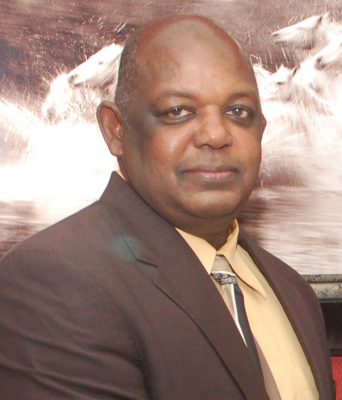The addition of a new 5.5 Megawatt (MW) generator is expected to boost the generating capacity of the Guyana Power and Light Incorporated (GPL) by yearend, while the company is undertaking works to upgrade its transmission system to reduce the number of outages experienced by customers, Chief Executive Officer (CEO) Albert Gordon has said.
“We received a 5.5 MW generator we purchased and we are moving to reinforce the transmission system to address intrinsic weaknesses that makes the system unstable,” Gordon told Sunday Stabroek in an interview last week.

The CEO said the utility company is also continuing to seek US$110 million needed to upgrade its systems.
“We are also pursuing financing from multilateral institutions… and have had some interest from the IDB [Inter-American Development Bank],” he noted.
A former Director-General of the Office of Utilities Regulation (OUR) in Jamaica, Gordon was appointed as GPL CEO in March of this year on a three-year contract. After his appointment, he said eliminating power outages was his number one priority and that the utility company would be seeking to access US$110 million for the immediate upgrade of its systems.
Gordon could not yet say if the IDB was willing to commit to any of the financing that would be required to begin the systems upgrade project but he remained optimistic given the bank’s interest as well as the funding and technical support it has given to GPL over the years.
“They has been a strong support in the past on projects for both financing capital projects and technical support,” he noted.
The GPL CEO noted that the 5.5 MW generator will be for use at the company’s Canefield, Berbice Power Station and will “provide much needed additional generation capacity” to the Demerara Berbice Interconnected System (DBIS).
While pointing out that many of the outages experienced by customers are due to the company’s old equipment and an archaic system supply model, Gordon said that GPL believes that the new generator would bring some relief to customers supplied by the DBIS system.
However, he cautioned that they should not expect an immediate relief before Christmas of this year.
“It would not be ready until, yes, about Christmas, because it is a process, where they have to build the station, connect it to the network, test it and all of that is work that requires time,” he explained.
Following his appointment in March, Gordon had stressed that the biggest problem for GPL was its aged system, which required significant upgrades.
“The biggest challenge now is keeping the lights on… so the first priority is to keep the lights on because the simplest of events on the distribution line… shuts the system down. Right now, there are serious deficiencies in the system that we know need a certain amount of investment…,” he had said at a cocktail reception held to welcome him earlier this year.
“I have already identified a number of things that we need to do. We’ll need just over US$110 million to deal with urgent matters, [such as] the re-configuration…and building some redundancy… just to get the systems in place,” he added.
He lamented the frequent shutdowns of GPL’s distribution system, saying that it needs to be urgently looked into. He pointed out that from records he has seen for last year alone, GPL had 25 entire system shutdowns, something he considered “very unusual” given that in other places a single occurrence would be cause for concern.
“The GPL system is evolving from a bunch of smaller systems that are being integrated and right now there are serious deficiencies in the system that we need to address,” he said.
“There are a lot of immediate actions that are needed to address the problems…Aside from that, about 50 MW of the generating capacity, which is just over 130 MW, is very old and in need of replacement. So they fail very regularly. We need to change that and many other things we have to do,” he added, while saying that another US$40 million would be needed for generation upgrades, bringing the total needed cash to about US$150 million.
GPL and its predecessor GEC have absorbed huge sums over the last 40 years but chronic problems and blackouts persist.
The US$110 million will be used to reroute and correct the current system, where distribution lines that take power to buildings are connected directly to the company’s generator. “That’s not how you configure a power system,” he said, as he explained that the power should be generated and sent to high voltage lines of sub-stations for the voltage to be broken down before being distributed to the customers. “In that way, the generator is shielded from events that may happen on the distribution lines that run along the road so right now that’s not the case with a number of sub-stations.”
Gordon told this newspaper last week that a system has already been worked out for how the upgrades will be done according to the funding received.
He said he does not believe that all of the $110 million required will come from one financier, which is why GPL has planned, according to most urgent, works to be done on the entire system.
GPL has said that customers received more interruptions for 2017 as compared to 2016 and this was mostly due to the faulty equipment and generator problems it faced.
“These generators are approximately 10 years old and normally we would have trouble-free operations [over] 15 to 20 years by just doing basic maintenance and reinsulating. What took place in 2017 is that the alternators used on the generators at [the] Kingston Two plant were not from the traditional manufacturer and we found that they developed both electrical and mechanical problems. One of the sets had to be out of operation from April to October,” GPL’s Deputy CEO Elwyn Marshall had told a Public Utilities Commission hearing earlier this year. He said that as a result they had to send the generator to Miami to have it repaired.
In addition to being without one of its generators, the company’s operational capability was also affected by planned maintenance on several Warstila generators, which Marshall said could not have been avoided.






